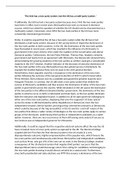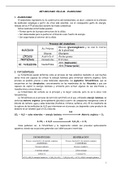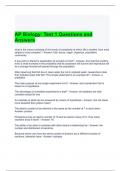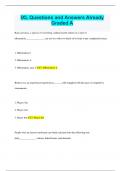‘The USA has a two party system, but the UK has a multi-party system.’
Traditionally, the UK has had a two party system because since 1945 the two main parties
have been in office, but in recent years third parties have seen an increase in electoral
success, which has raised the question of whether the UK should now be characterised as a
multi-party system. Conversely, since 1853 the two main parties in the US have more
consistently dominated government.
Firstly, it could be argued that the US has a two party system while the UK has in fact
developed a multi-party system, because of the varying levels of respective dominance of
the two main parties in both countries. In the UK, the dominance of the two main parties
have fluctuated in recent years, which has resulted in the influence of a third party in
government in the years 2010 to 2015 under the coalition of the Conservative and Liberal
Democrat parties. Furthermore, the last Prime Minister, Theresa May, headed a minority
government and had to form an agreement with third party, the Democratic Unionist Party;
demonstrating the growing weakness of the two parties as neither could get a considerable
majority in the 2017 election. Another indicator of the decrease of exclusive dominance of
the two main parties is the way third parties have also gained success in Parliament, for
example the Scottish National Party won 56 seats in the 2015 general election.
Nevertheless, there arguably could be a resurgence in the dominance of the two main
parties following the outcome of the last general election of 2019 in which Conservative
Prime Minister, Boris Johnson won by a landslide and gained the greatest majority since
Margaret Thatcher. In contrast, the US still retain a two party system that inhibits the
success of third party candidates and thus ensures the dominance of either of the two main
parties in government across the country. While devolution in the UK causes the dominance
of the two parties in the different devolved bodies’ government, the dominance of the two
parties in America occur on both a nationwide and state basis, as the two parties dominate
both the executive and legislative branch, in addition to all 50 state governors belonging to
either one of the two main parties, displaying that even the supposed ’50 state system’
across the states is still dominated by either Republicans or Democrats. Even the two
independent senators, Bernie Sanders and Angus King, entered the primaries as Democrats,
which could be because of the ‘big tent politics’ in the US and the ‘catch-all’ nature of the
two parties that allows a wider variety of ideologies so the two main parties apply to various
groups of the electorate, undermining third parties or independent candidates as a viable
option. However, there are rare occurrences of them still seeing some extent of success as
Jess Venture was an independent governor for Minnesota.
Additionally, it could be argued that the respective electoral systems affect the way the US
have remained more of a two party system as opposed to the UK. The Electoral College
coupled with the First Past the Post electoral system in the US results in a very
disproportionate outcome, highly unrepresentative of the popular vote, which favours the
two main parties and simultaneously undermines third parties and independent candidates,
such as Ross Perot, who got 19% of the vote yet no votes in the Electoral College. Another
consequence of the US electoral system that negates third parties’ success is that the
disproportional nature would discourage voters from voting for candidates not belonging to
the two main parties knowing it would almost certainly be a wasted vote. Furthermore,
since both presidential and state elections use FPTP this ensures a dominance of the two
Traditionally, the UK has had a two party system because since 1945 the two main parties
have been in office, but in recent years third parties have seen an increase in electoral
success, which has raised the question of whether the UK should now be characterised as a
multi-party system. Conversely, since 1853 the two main parties in the US have more
consistently dominated government.
Firstly, it could be argued that the US has a two party system while the UK has in fact
developed a multi-party system, because of the varying levels of respective dominance of
the two main parties in both countries. In the UK, the dominance of the two main parties
have fluctuated in recent years, which has resulted in the influence of a third party in
government in the years 2010 to 2015 under the coalition of the Conservative and Liberal
Democrat parties. Furthermore, the last Prime Minister, Theresa May, headed a minority
government and had to form an agreement with third party, the Democratic Unionist Party;
demonstrating the growing weakness of the two parties as neither could get a considerable
majority in the 2017 election. Another indicator of the decrease of exclusive dominance of
the two main parties is the way third parties have also gained success in Parliament, for
example the Scottish National Party won 56 seats in the 2015 general election.
Nevertheless, there arguably could be a resurgence in the dominance of the two main
parties following the outcome of the last general election of 2019 in which Conservative
Prime Minister, Boris Johnson won by a landslide and gained the greatest majority since
Margaret Thatcher. In contrast, the US still retain a two party system that inhibits the
success of third party candidates and thus ensures the dominance of either of the two main
parties in government across the country. While devolution in the UK causes the dominance
of the two parties in the different devolved bodies’ government, the dominance of the two
parties in America occur on both a nationwide and state basis, as the two parties dominate
both the executive and legislative branch, in addition to all 50 state governors belonging to
either one of the two main parties, displaying that even the supposed ’50 state system’
across the states is still dominated by either Republicans or Democrats. Even the two
independent senators, Bernie Sanders and Angus King, entered the primaries as Democrats,
which could be because of the ‘big tent politics’ in the US and the ‘catch-all’ nature of the
two parties that allows a wider variety of ideologies so the two main parties apply to various
groups of the electorate, undermining third parties or independent candidates as a viable
option. However, there are rare occurrences of them still seeing some extent of success as
Jess Venture was an independent governor for Minnesota.
Additionally, it could be argued that the respective electoral systems affect the way the US
have remained more of a two party system as opposed to the UK. The Electoral College
coupled with the First Past the Post electoral system in the US results in a very
disproportionate outcome, highly unrepresentative of the popular vote, which favours the
two main parties and simultaneously undermines third parties and independent candidates,
such as Ross Perot, who got 19% of the vote yet no votes in the Electoral College. Another
consequence of the US electoral system that negates third parties’ success is that the
disproportional nature would discourage voters from voting for candidates not belonging to
the two main parties knowing it would almost certainly be a wasted vote. Furthermore,
since both presidential and state elections use FPTP this ensures a dominance of the two











